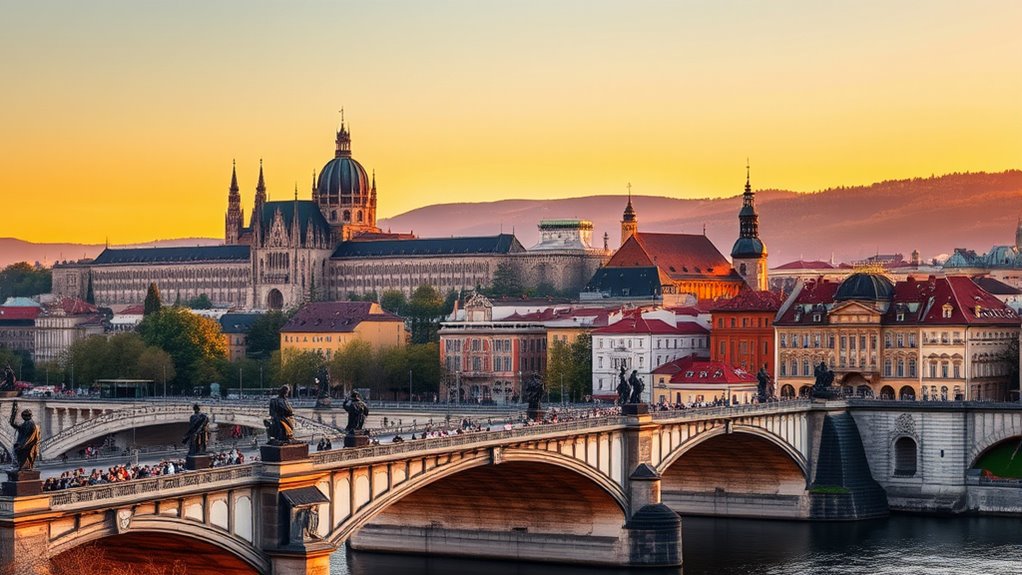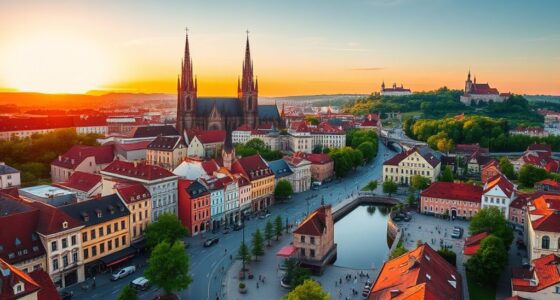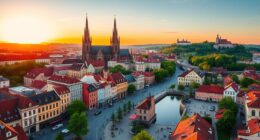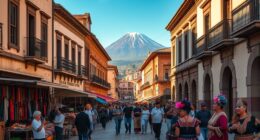Discover Czechia’s top attractions, including UNESCO World Heritage sites like Prague’s historic center, Český Krumlov castle, and the charming town of Telč. Explore stunning Gothic, Renaissance, and Baroque architecture, and enjoy natural wonders such as Šumava National Park and the Moravian Karst caves. Modern landmarks like Villa Tugendhat and vibrant contemporary art spaces provide a fresh perspective. Continue exploring to uncover even more amazing sights and cultural gems across this diverse country.
Key Takeaways
- UNESCO World Heritage Sites like Prague’s historic center, Český Krumlov, and Kutná Hora showcase Czechia’s rich cultural and architectural heritage.
- Architectural landmarks such as Prague’s St. Vitus Cathedral, Villa Tugendhat, and the Dancing House highlight diverse styles from Gothic to modernist.
- Natural wonders including Šumava National Park, Elbe Sandstones, and Moravian Karst offer stunning landscapes and outdoor activities.
- Contemporary art venues and innovative cultural spaces like DOX Centre and pop-up art hubs foster creative expression.
- The Lednice-Valtice cultural landscape and medieval sites like St. Barbara’s Church exemplify natural beauty and historical significance.
Historic City Centers and UNESCO World Heritage Sites
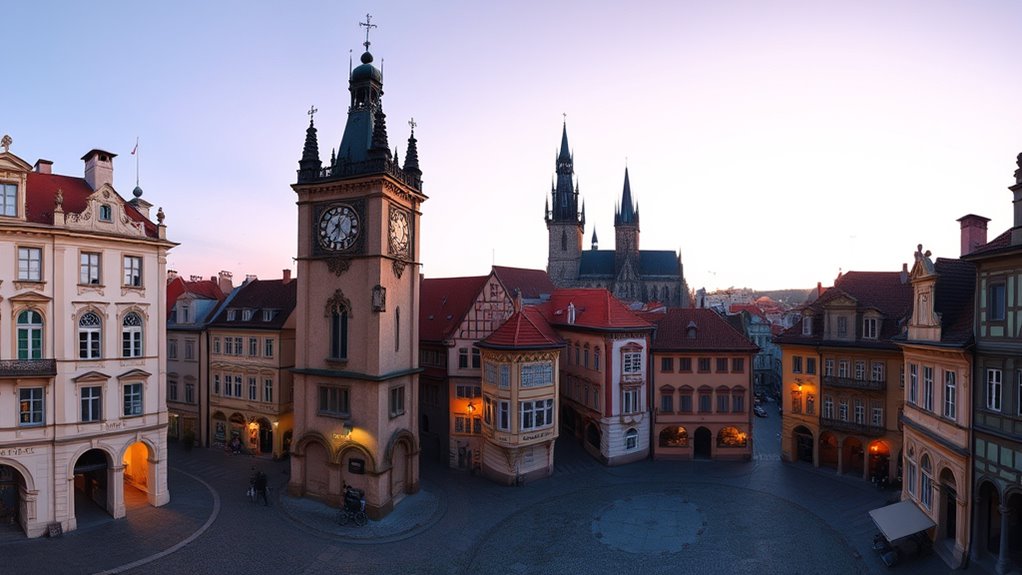
Czechia boasts several historic city centers recognized as UNESCO World Heritage Sites, each offering a glimpse into its rich cultural past. When you explore these areas, you’ll see centuries-old architecture, cobblestone streets, and iconic landmarks. In Prague, the historic center features the majestic Hradcany Castle and the medieval Charles Bridge, both symbols of Czech history. Český Krumlov enchants visitors with its 13th-century castle and picturesque Old Town that blend Gothic, Renaissance, and Baroque styles. Telč stands out for its beautifully preserved Renaissance buildings and charming square. Kutná Hora impresses with its striking St. Barbara’s Church and the eerie Sedlec Ossuary. These sites preserve the country’s heritage while inviting you to step back in time and experience Czechia’s vibrant history firsthand. Preservation efforts play a vital role in maintaining these UNESCO sites for future generations.
Architectural and Cultural Landmarks

Czechia’s architectural and cultural landmarks showcase a rich mix of styles and history that you can’t miss. From UNESCO sites like Prague’s historic center to modernist designs like Villa Tugendhat, each tells a unique story. Exploring these venues reveals the country’s diverse heritage and artistic achievements. For those interested in sustainable energy practices, some landmarks incorporate innovative energy solutions that highlight Czechia’s commitment to environmental responsibility.
Iconic UNESCO Sites
Among the most iconic UNESCO sites in Czechia are its remarkable architectural and cultural landmarks that showcase the country’s rich history. These sites evoke a sense of wonder and pride, reflecting centuries of artistic achievement and cultural resilience. Picture strolling across the historic Charles Bridge, gazing at statues that have stood for generations. Imagine exploring Prague’s Old Town, where every cobblestone whispers stories of the past. The Český Krumlov castle offers a fairy-tale atmosphere, while Kutná Hora’s ossuary stirs awe and reflection. These UNESCO sites connect you to Czechia’s vibrant history, inspiring admiration for its timeless beauty.
| Site | Significance |
|---|---|
| Charles Bridge | Iconic symbol of Prague’s history |
| Český Krumlov Castle | Medieval, Renaissance, Baroque blend |
| Kutná Hora’s Ossuary | Unique, haunting reflection of history |
| Historic Prague Center | Cultural heart of Czechia, UNESCO site |
Notable Architectural Styles
Architectural styles in Czechia showcase a diverse tapestry of historical influences, from medieval fortifications to modernist masterpieces. You’ll notice Gothic structures like Prague’s St. Vitus Cathedral, with soaring spires and intricate stained glass. Renaissance buildings, such as Český Krumlov’s castle, feature ornate facades and elegant courtyards. Baroque landmarks like the Pilgrimage Church of St. John of Nepomuk display dramatic curves and opulent details. In the 20th century, functionalist architecture shines through Villa Tugendhat in Brno, emphasizing simple lines and open spaces. Art Nouveau elements also appear in Prague’s residential buildings, with floral motifs and decorative ironwork. This rich mix reflects the country’s layered history and cultural evolution, making Czechia a fascinating destination for architecture enthusiasts. Additionally, the preservation and restoration of these diverse styles highlight the importance of maintaining architectural heritage for future generations.
Cultural Heritage Venues
Cultural heritage venues in Czechia showcase a rich array of architectural and cultural landmarks that reflect the country’s diverse history. You’ll find UNESCO sites like Prague’s Historic Centre, home to Hradcany Castle and Charles Bridge, offering stunning views and medieval charm. Český Krumlov’s well-preserved castle blends Gothic, Renaissance, and Baroque elements, making it a must-see. Kutná Hora’s Sedlec Ossuary and St. Barbara’s Church highlight the country’s religious and artistic heritage. In Brno, Villa Tugendhat exemplifies functionalist architecture, while the Cesky Krumlov Theater within the castle complex offers cultural performances. These venues let you immerse yourself in Czechia’s rich cultural tapestry, showcasing invaluable architectural styles and historical significance that continue to attract visitors worldwide. Promoting attention in creative practice, these sites exemplify how focused appreciation can deepen connection to cultural landmarks.
Natural Wonders and Scenic Landscapes
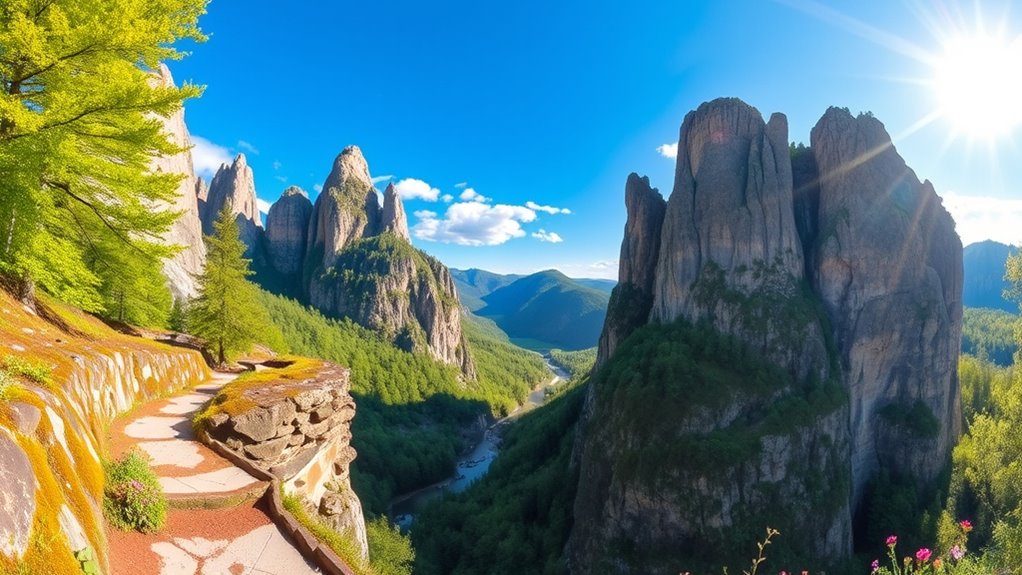
Czechia boasts a stunning array of natural wonders and scenic landscapes that captivate visitors from all around. You can explore the breathtaking Šumava National Park, where dense forests, glacial lakes, and rolling hills create a serene escape. The Elbe Sandstones offer dramatic cliffs and unique rock formations perfect for hiking and photography. The Jizerské Mountain Beechwoods are part of the ancient beech forests shared across Europe, providing lush greenery and peaceful trails. The Lednice-Valtice Area enchants with its picturesque lakes, forests, and sprawling gardens, making it a UNESCO cultural landscape. For stunning vistas, visit the Czech-Moravian Highlands or the scenic terrain of the Moravian Karst, home to mesmerizing caves and underground rivers. These landscapes provide a perfect blend of natural beauty and outdoor adventure. Utilizing sustainable conservation practices can help preserve these natural treasures for future generations.
Modern Marvels and Contemporary Attractions

Czechia’s modern attractions showcase innovative design and creative energy that complement its rich history. You can explore iconic architectural landmarks, vibrant contemporary art scenes, and dynamic cultural spaces that reflect the country’s evolving spirit. These sites invite you to experience Czechia’s forward-looking side firsthand. Building and maintaining backyard greenhouses demonstrates the country’s commitment to sustainable and innovative practices, paralleling its modern architectural and cultural achievements.
Modern Architectural Icons
Have you ever marveled at how modern architecture transforms city skylines? Czechia boasts several iconic structures that showcase innovative design and engineering. In Brno, Villa Tugendhat stands out as a masterpiece of functionalist architecture, blending form and function seamlessly. Prague’s DOX Centre for Contemporary Art pushes boundaries with its striking, unconventional design, serving as a hub for modern creativity. The Dancing House, also known as Fred and Ginger, in Prague offers a playful, deconstructivist silhouette that defies traditional building styles. These modern icons reflect Czechia’s embrace of contemporary architecture, blending aesthetic appeal with cultural expression. Visiting these landmarks gives you insight into the country’s creative spirit and its commitment to pushing architectural boundaries beyond historic styles. Modern architectural designs showcase the country’s innovative spirit and dedication to embracing the future of urban development.
Vibrant Contemporary Art
Modern architecture in Czechia continues to inspire with its bold, innovative designs, reflecting the country’s dynamic cultural scene. As you explore its vibrant contemporary art, you’ll encounter cutting-edge galleries, lively street art, and innovative installations that push creative boundaries. Czech cities embrace modernity while honoring tradition, creating an enthralling juxtaposition. You might find yourself enthralled by:
- Dynamic street murals transforming urban landscapes
- Contemporary galleries showcasing emerging Czech artists
- Interactive public art installations engaging visitors
- Avant-garde sculptures in city squares
- Modern art festivals that celebrate creative experimentation
- Public art initiatives fostering community engagement and artistic expression
These vibrant expressions reflect Czechia’s evolving identity, inviting you to experience its creative spirit firsthand. Whether wandering through galleries or exploring outdoor murals, you’ll discover a thriving scene that celebrates innovation and artistic freedom at every turn.
Innovative Cultural Spaces
Innovative cultural spaces in Czechia are transforming the way you experience art and creativity. Modern venues like the Villa Tugendhat in Brno showcase groundbreaking architecture that blends functionality with aesthetic innovation. In Prague, contemporary galleries and museums push boundaries by hosting cutting-edge exhibitions, digital art, and immersive installations. These spaces foster collaboration among artists, designers, and innovators, creating dynamic environments for cultural exchange. You’ll find pop-up art hubs, experimental theaters, and creative co-working spaces that challenge traditional notions of art consumption. Supporting emotional expression is also encouraged through participatory art projects and interactive workshops. Czechia’s modern cultural spaces reflect a vibrant, forward-thinking spirit, making it easier for you to engage with fresh ideas and new forms of expression. Whether exploring sleek galleries or participating in interactive workshops, you’ll discover a thriving scene that celebrates ingenuity and contemporary creativity.
Regional Destinations and Local Heritage
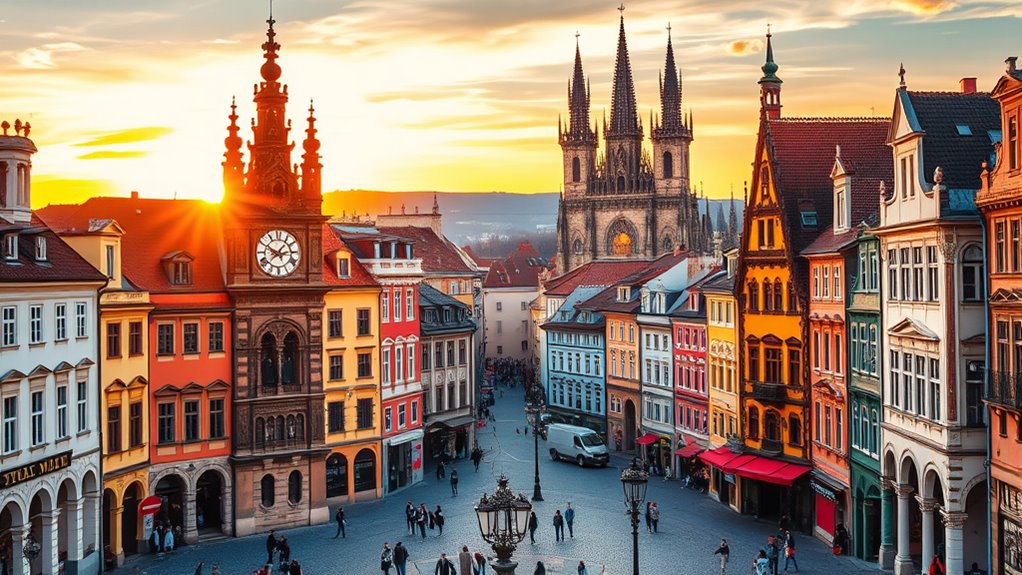
Regional destinations in Czechia showcase a diverse tapestry of local heritage, reflecting centuries of cultural evolution. As you explore, you’ll encounter vibrant towns, historic architecture, and unique traditions. Feel the charm of these places and connect with their stories. Here are some highlights to inspire you:
- Wander through Český Krumlov’s enchanting castle and cobblestone streets.
- Experience the medieval atmosphere of Telč’s Renaissance architecture.
- Discover the rich history behind Kutná Hora’s St. Barbara’s Church.
- Stroll the ancient streets of Jihlava, filled with cultural relics.
- Immerse yourself in South Bohemia’s picturesque landscapes and quaint villages.
- Pay attention to architectural details that showcase regional craftsmanship and design influences.
These destinations offer authentic experiences, blending history, culture, and natural beauty into unforgettable memories. Plunge into Czechia’s local heritage and uncover its timeless allure.
Notable UNESCO Sites Across Czechia

Czechia is home to several UNESCO World Heritage Sites that highlight its rich cultural and natural heritage. You can explore Prague’s Historic Centre, with iconic landmarks like Charles Bridge and Hradcany Castle, showcasing centuries of history. In Český Krumlov, a 13th-century castle complex offers Gothic, Renaissance, and Baroque architecture. Telč’s well-preserved Renaissance townscape invites you to wander its picturesque squares. The Lednice-Valtice Area presents a stunning cultural landscape of castles, lakes, and parks. Kutná Hora features the mesmerizing Sedlec Ossuary and St. Barbara’s Church, reflecting its medieval significance. Additionally, the Ancient and Primeval Beech Forests of the Carpathians, shared across 17 countries, protect pristine natural beauty. These UNESCO sites give you a glimpse into Czechia’s diverse and enthralling heritage.
Frequently Asked Questions
What Are the Best Times of Year to Visit Czechia’s Top Attractions?
You should visit Czechia in late spring (May-June) or early fall (September-October) when the weather is pleasant and crowds are manageable. Summer (July-August) is lively, but busy at popular sites. Winter (December-February) offers a magical atmosphere, especially in Prague and mountain regions, perfect for enjoying festive markets and snowy landscapes. Avoid peak holiday season to experience the attractions with less congestion and better weather conditions.
Are Guided Tours Available for the UNESCO World Heritage Sites?
Guided tours are definitely available for UNESCO World Heritage Sites in Czechia, and they’re an absolute treasure trove of history and culture. You’ll find expert guides who bring these sites to life with enthralling stories and detailed insights. Whether you prefer walking through Prague’s Old Town, exploring Český Krumlov Castle, or visiting Lednice-Valtice, these tours make discovering Czechia’s heritage an unforgettable experience, like stepping into a living history book.
Which Attractions Are Suitable for Visitors With Limited Mobility?
You’ll find many attractions suitable for visitors with limited mobility in Czechia. The Prague Castle complex offers accessible routes, elevators, and ramps. Charles Bridge has been partially adapted, and many museums and galleries in Prague are wheelchair friendly. In Český Krumlov, some areas are accessible, though cobblestone streets may pose challenges. Always verify ahead for specific accessibility features at each site to ensure a comfortable visit.
How Can Travelers Access Remote Natural Parks and Scenic Landscapes?
You can access remote natural parks and scenic landscapes in Czechia by planning ahead and using guided tours or transportation services. Many parks offer shuttle buses, especially during peak seasons, making it easier for you to explore without long hikes. Rent a car for more flexibility, or join organized excursions that include transportation, giving you a comfortable way to enjoy the country’s beautiful and secluded natural treasures.
Are There Recommended Itineraries for Exploring Multiple Regions Efficiently?
Think of Czechia as a tapestry waiting to be unraveled. You can explore multiple regions efficiently by planning a loop starting in Prague, then heading south to South Bohemia for Český Krumlov, followed by Moravia’s Brno and the UNESCO-listed Lednice-Valtice area. Use trains and car rentals for flexibility. Allocate days wisely to soak in each area’s unique charm, making your journey a vibrant mosaic of Czechia’s diverse landscapes.
Conclusion
As you explore Czechia, you’ll find its treasures like a tapestry woven with history, architecture, and nature. Each site, from bustling city centers to serene landscapes, offers a unique chapter of its story. Think of Czechia as a jewel box, each gem revealing a new wonder. Embrace these attractions, and let them ignite your curiosity and wonder, turning your journey into a vibrant mosaic of unforgettable memories.

